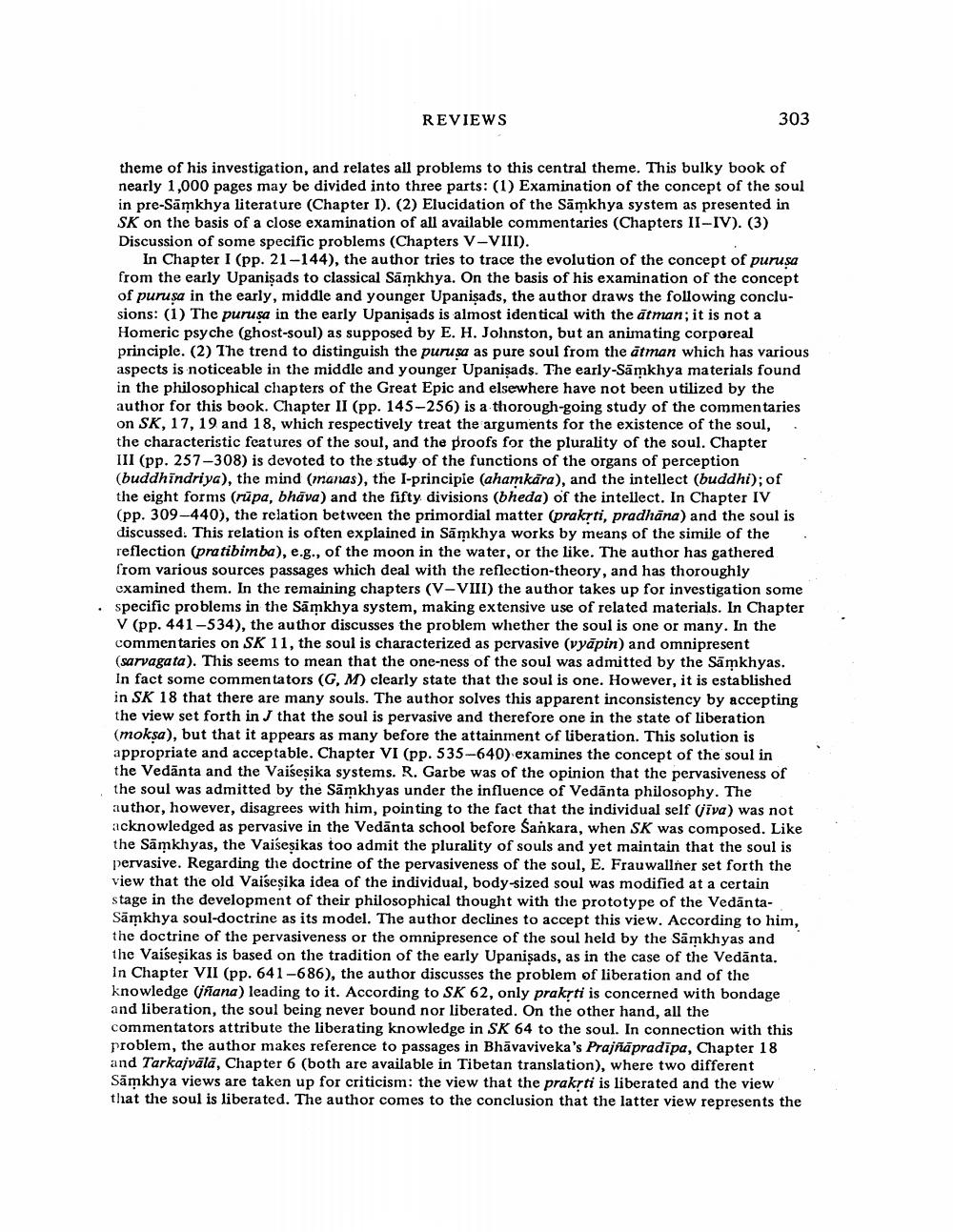________________
REVIEWS
303
theme of his investigation, and relates all problems to this central theme. This bulky book of nearly 1,000 pages may be divided into three parts: (1) Examination of the concept of the soul in pre-Samkhya literature (Chapter I). (2) Elucidation of the Samkhya system as presented in SK on the basis of a close examination of all available commentaries (Chapters II-IV). (3) Discussion of some specific problems (Chapters V-VIII).
In Chapter I (pp. 21-144), the author tries to trace the evolution of the concept of purusa from the early Upanisads to classical Samkhya. On the basis of his examination of the concept of purusa in the early, middle and younger Upanisads, the author draws the following conclusions: (1) The purusa in the early Upanisads is almost identical with the atman; it is not a Homeric psyche (ghost-soul) as supposed by E. H. Johnston, but an animating corporeal principle. (2) The trend to distinguish the purusa as pure soul from the atman which has various aspects is noticeable in the middle and younger Upanisads. The early-Samkhya materials found in the philosophical chapters of the Great Epic and elsewhere have not been utilized by the author for this book. Chapter II (pp. 145-256) is a thorough-going study of the commentaries on SK, 17, 19 and 18, which respectively treat the arguments for the existence of the soul, the characteristic features of the soul, and the proofs for the plurality of the soul. Chapter III (pp. 257-308) is devoted to the study of the functions of the organs of perception (buddhindriya), the mind (manas), the I-principie (ahamkara), and the intellect (buddhi); of the eight forms (rūpa, bhāva) and the fifty divisions (bheda) of the intellect. In Chapter IV (pp. 309-440), the relation between the primordial matter (prakṛti, pradhāna) and the soul is discussed. This relation is often explained in Samkhya works by means of the simile of the reflection (pratibimba), e.g., of the moon in the water, or the like. The author has gathered from various sources passages which deal with the reflection-theory, and has thoroughly examined them. In the remaining chapters (V-VIII) the author takes up for investigation some specific problems in the Samkhya system, making extensive use of related materials. In Chapter V (pp. 441-534), the author discusses the problem whether the soul is one or many. In the commentaries on SK 11, the soul is characterized as pervasive (vyāpin) and omnipresent (sarvagata). This seems to mean that the one-ness of the soul was admitted by the Samkhyas. In fact some commentators (G, M) clearly state that the soul is one. However, it is established in SK 18 that there are many souls. The author solves this apparent inconsistency by accepting the view set forth in J that the soul is pervasive and therefore one in the state of liberation (mokṣa), but that it appears as many before the attainment of liberation. This solution is appropriate and acceptable. Chapter VI (pp. 535-640) examines the concept of the soul in the Vedanta and the Vaiseṣika systems. R. Garbe was of the opinion that the pervasiveness of the soul was admitted by the Samkhyas under the influence of Vedanta philosophy. The author, however, disagrees with him, pointing to the fact that the individual self (jiva) was not acknowledged as pervasive in the Vedanta school before Sankara, when SK was composed. Like the Samkhyas, the Vaiseṣikas too admit the plurality of souls and yet maintain that the soul is pervasive. Regarding the doctrine of the pervasiveness of the soul, E. Frauwallner set forth the view that the old Vaiseṣika idea of the individual, body-sized soul was modified at a certain stage in the development of their philosophical thought with the prototype of the VedantaSamkhya soul-doctrine as its model. The author declines to accept this view. According to him, the doctrine of the pervasiveness or the omnipresence of the soul held by the Samkhyas and the Vaiseṣikas is based on the tradition of the early Upanisads, as in the case of the Vedanta. In Chapter VII (pp. 641-686), the author discusses the problem of liberation and of the knowledge (jñana) leading to it. According to SK 62, only prakṛti is concerned with bondage and liberation, the soul being never bound nor liberated. On the other hand, all the commentators attribute the liberating knowledge in SK 64 to the soul. In connection with this problem, the author makes reference to passages in Bhavaviveka's Prajñāpradipa, Chapter 18 and Tarkajvälä, Chapter 6 (both are available in Tibetan translation), where two different Samkhya views are taken up for criticism: the view that the prakṛti is liberated and the view that the soul is liberated. The author comes to the conclusion that the latter view represents the




